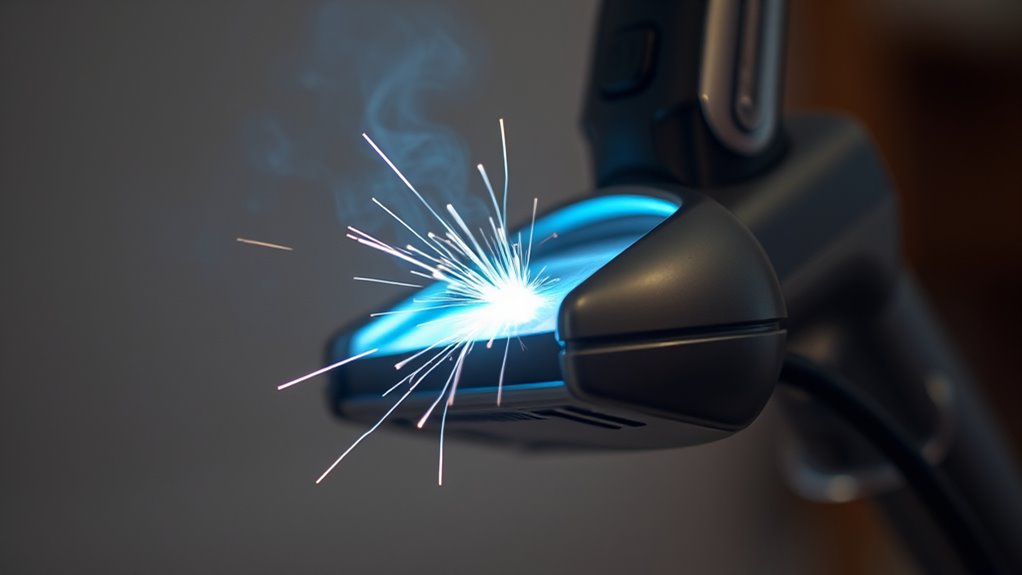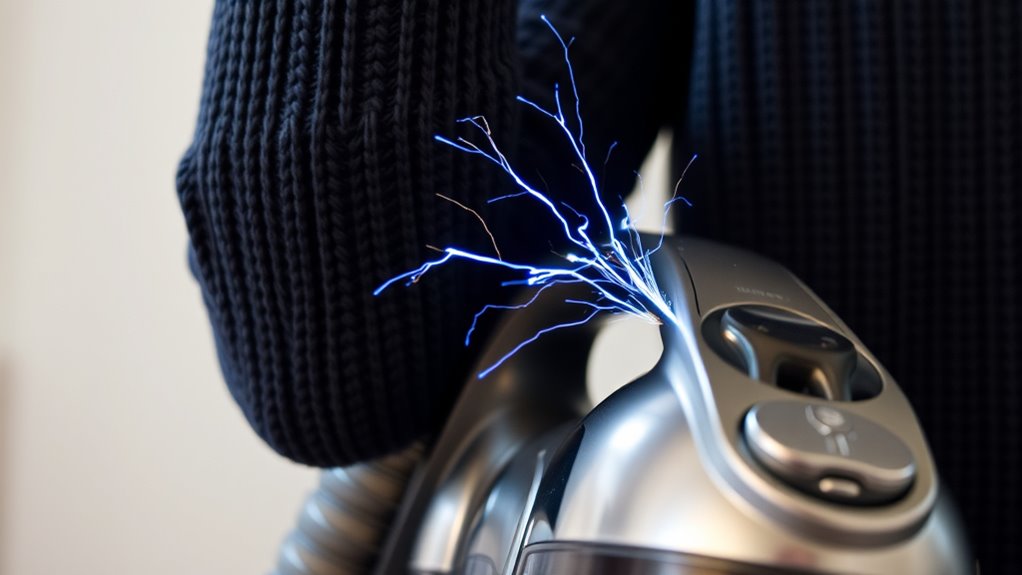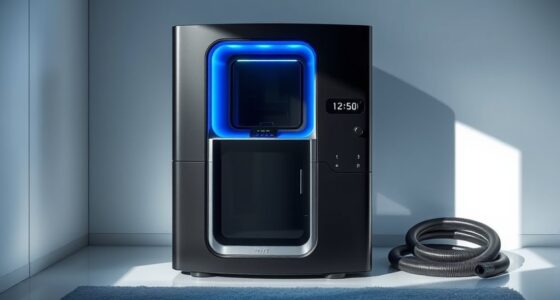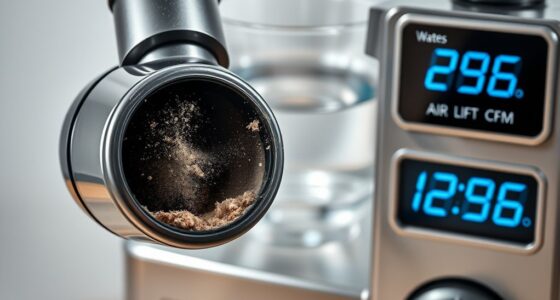Static electricity in vacuums can create surprising risks you should know. As you use your vacuum, friction between plastic parts and carpets can cause static buildup, leading to sparks or shocks. In some environments, these sparks might ignite flammable vapors or dust, posing fire hazards. To stay safe, make certain your vacuum is properly grounded and avoid vacuuming in risky areas. If you want to understand how to prevent these dangers and protect yourself, keep exploring these vital tips.
Key Takeaways
- Static buildup occurs when plastic vacuum parts and carpets rub, creating electrical charge that can discharge suddenly.
- Sparks from static discharges can ignite flammable vapors or dust in hazardous environments.
- Improper grounding or damaged cords increase static risk and potential for dangerous static shocks.
- Static electricity may damage sensitive electronic components inside the vacuum.
- Preventative measures include grounding the vacuum, using anti-static sprays, and avoiding vacuuming flammable areas.

Have you ever noticed how a vacuum cleaner can cause sparks or a shock when you touch its metal parts? That sudden jolt is a classic example of electrostatic discharge, or ESD, which occurs when built-up static electricity finds a quick path to ground. While it might seem harmless, this static buildup can pose risks beyond just a small shock. Understanding how static electricity interacts with vacuums can help you stay safe and avoid potential hazards.
Vacuum cleaners, especially those with plastic components and rubber wheels, often generate static electricity as they move across carpets or rugs. The friction between these materials causes electrons to transfer, creating an imbalance of charge. When you reach out and touch the vacuum’s metal parts, the accumulated static discharges as a quick, visible spark. This is ESD in action. Although generally harmless, the discharge can ignite flammable vapors or dust in certain environments, making it a notable safety concern.
Vacuum movement over carpets causes static sparks, which can ignite flammable vapors or dust, posing safety risks.
To prevent static buildup and its associated risks, you should follow some simple vacuum safety tips. First, ensure your vacuum is properly grounded. Many modern vacuums come with grounding features, but if yours doesn’t, avoid using it on highly flammable or dusty surfaces. Before plugging in, check the power cord and plug for damage, as compromised wiring can increase static risks. When vacuuming, try to keep a steady, smooth motion, and avoid abrupt movements that can cause more friction and static buildup. Wearing natural fibers like cotton clothing can also reduce static generation, compared to synthetic fabrics that tend to hold more static charge.
Another effective tip is to use anti-static sprays or mats if you frequently vacuum in areas with flammable vapors or dust. These products help dissipate static charges and reduce the likelihood of sparks. Additionally, before touching metal parts of the vacuum after extensive use, consider touching a grounded object to discharge any static buildup safely. This simple step can prevent those surprising shocks and reduce the chance of accidental ignition. Furthermore, ongoing advancements in robotics and automation aim to develop safer, more efficient cleaning devices that minimize static risks, especially in sensitive environments.
Frequently Asked Questions
Can Static Electricity Damage Vacuum Motors?
Yes, static electricity can damage vacuum motors through electrostatic damage. When you use a vacuum, static buildup can discharge unexpectedly, potentially harming sensitive components inside the motor. To guarantee vacuum safety, avoid using the vacuum on highly static-prone surfaces and consider grounding techniques. This helps prevent electrostatic discharge, protecting your vacuum’s motor and extending its lifespan. Staying aware of static risks keeps your vacuum working efficiently and safely.
Are Certain Vacuum Models More Prone to Static Buildup?
Think of some vacuum models as more sensitive to certain conditions. You might notice that vacuum design influences static buildup, making some static prone models more likely to generate static electricity. These models often have less effective grounding or use materials that retain static. If you want to avoid static shocks, choose vacuums with better grounding features and consider models designed to minimize static buildup.
How Can I Prevent Static Shocks While Vacuuming?
To prevent static shocks while vacuuming, you should use effective grounding techniques, such as touching a metal object before you start and ensuring your vacuum is properly grounded. Additionally, choose fabrics like cotton for clothing, as they generate less static than synthetic materials. Regularly humidify your space, which helps reduce static buildup. These steps can considerably minimize shocks and make your vacuuming experience safer and more comfortable.
Is Static Electricity a Fire Hazard With Vacuums?
You’re right to worry about static electricity and fire safety with vacuums. Electrostatic hazards can build up during vacuuming, especially with dry or synthetic materials, creating a small risk of sparks. While rare, these sparks can ignite flammable gases or vapors, so it’s vital to guarantee proper grounding and avoid vacuuming near combustible substances. Always follow safety practices to minimize static risks and maintain a safe environment.
Do Humidifiers Reduce Static Electricity in Vacuum Cleaning?
Using a humidifier can be effective in reducing static electricity during vacuum cleaning. By increasing humidity levels, you create an environment that lessens static buildup, making static reduction techniques more successful. Humidifiers add moisture to the air, which helps prevent static sparks and potential fire hazards. So, if static electricity is a concern, running a humidifier in the room can be a simple and effective way to improve safety during vacuuming.
Conclusion
Just like a spark can surprise you unexpectedly, static electricity in vacuums can pose hidden risks. By staying aware and handling your vacuum carefully, you prevent surprises that could cause shocks or damage. Think of it as riding a bike—you’re in control, but you still need to watch out for bumps. Keep safety in mind, and you’ll keep your cleaning routine smooth and shock-free. Stay informed, stay safe, and enjoy a hassle-free cleaning experience.









